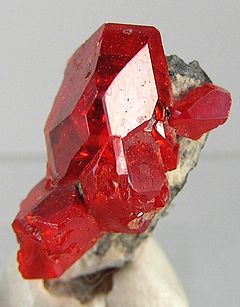Tetraarsenic tetrasulfide
| Realgar | |
|---|---|

Realgar crystals, Royal Reward Mine, King County, Washington, US
|
|
| General | |
| Category | Sulfide mineral |
|
Formula (repeating unit) |
As4S4 or AsS |
| Strunz classification | 2.FA.15a |
| Crystal system | Monoclinic |
| Crystal class | Prismatic (2/m) (same H-M symbol) |
| Unit cell | a = 9.325(3) Å b = 13.571(5) Å c = 6.587(3) Å β = 106.43°; Z = 16 |
| Identification | |
| Color | Red to yellow-orange; in polished section, pale gray, with abundant yellow to red internal reflections |
| Crystal habit | Prismatic striated crystals; more commonly massive, coarse to fine granular, or as incrustations |
| Twinning | Contact twins on {100} |
| Cleavage | Good on {010}; less so on {101}, {100}, {120}, and {110} |
| Tenacity | Sectile, slightly brittle |
| Mohs scale hardness | 1.5–2 |
| Luster | Resinous to greasy |
| Streak | Red-orange to red |
| Diaphaneity | Transparent |
| Specific gravity | 3.56 |
| Optical properties | Biaxial (-) |
| Refractive index | nα = 2.538 nβ = 2.684 nγ = 2.704 |
| Birefringence | δ = 0.166 |
| Pleochroism | Nearly colorless to pale golden yellow |
| 2V angle | 40° |
| Dispersion | r > v, very strong |
| Other characteristics |
Toxic and carcinogenic. Disintegrates on long exposure to light to a powder composed of pararealgar or arsenolite and orpiment. |
| References | |
Toxic and carcinogenic.
Realgar, α-As4S4, is an arsenic sulfide mineral, also known as "ruby sulphur" or "ruby of arsenic". It is a soft, sectile mineral occurring in monoclinic crystals, or in granular, compact, or powdery form, often in association with the related mineral, orpiment (As2S3). It is orange-red in color, melts at 320 °C, and burns with a bluish flame releasing fumes of arsenic and sulfur. Realgar is soft with a Mohs hardness of 1.5 to 2 and has a specific gravity of 3.5. Its streak is orange colored. It is trimorphous with alacranite and pararealgar. Its name comes from the Arabic rahj al-ġār (رهج الغار, "powder of the mine"), via Catalan and Medieval Latin, and its earliest record in English is in the 1390s.
Realgar most commonly occurs as a low-temperature hydrothermal vein mineral associated with other arsenic and antimony minerals. It also occurs as volcanic sublimations and in hot spring deposits. It occurs in association with orpiment, arsenolite, calcite and barite.
It is found with lead, silver and gold ores in Hungary, Bohemia and Saxony. In the US it occurs notably in Mercur, Utah; Manhattan, Nevada and in the geyser deposits of Yellowstone National Park.
...
Wikipedia
